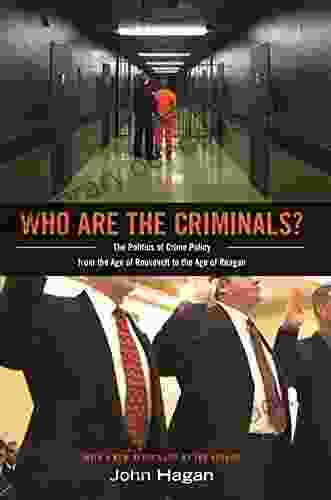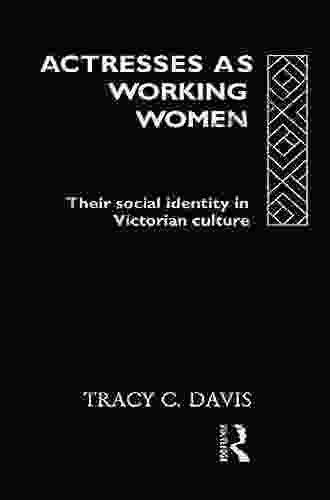Who Are The Criminals: An In-Depth Exploration of Criminal Behavior and Its Causes


Crime is a significant societal issue that impacts communities worldwide. Understanding the nature of criminal behavior and its causes is crucial for developing effective strategies to prevent and combat crime. This comprehensive article delves into the complex world of criminals, examining their motivations, patterns, and the interplay of biological, psychological, and social factors that contribute to their actions.
4.7 out of 5
| Language | : | English |
| File size | : | 3050 KB |
| Text-to-Speech | : | Enabled |
| Screen Reader | : | Supported |
| Enhanced typesetting | : | Enabled |
| Word Wise | : | Enabled |
| Print length | : | 293 pages |
Types of Criminals
Criminals can be categorized based on the severity and nature of their crimes. Some of the most common types include:
* Violent criminals: Individuals who commit offenses involving physical harm, such as murder, assault, or robbery. * Property criminals: Those who engage in crimes related to stealing or damaging property, including burglary, theft, and vandalism. * White-collar criminals: Individuals who commit non-violent crimes for financial gain, such as fraud, embezzlement, and money laundering. * Organized crime members: Individuals involved in structured criminal organizations that engage in large-scale, systematic criminal activities. * Cybercriminals: Those who commit crimes using computers and the internet, such as hacking, identity theft, and online fraud.
Motivations for Criminal Behavior
The motivations behind criminal behavior are multifaceted and can vary greatly depending on the individual and the specific crime committed. Some of the common factors that contribute to criminality include:
* Financial gain: Many crimes are driven by the desire for financial benefits, such as stealing money or property for personal use or financial profit. * Power and control: Some criminals seek power and dominance over others, leading them to commit crimes such as assault, intimidation, or sexual violence. * Status and recognition: Criminal behavior can also be motivated by a desire for status and recognition within certain social groups or subcultures. * Anger and revenge: Crimes driven by emotions such as anger, resentment, or a desire for revenge can range from minor property damage to violent offenses. * Mental illness: Individuals with mental health disorders may experience impaired judgment and impulse control, which can increase their risk of engaging in criminal behavior.
Biological and Psychological Factors
Research has identified certain biological and psychological factors that may be associated with an increased risk of criminal behavior. These include:
* Genetic influences: Some studies suggest that genetic factors may contribute to an individual's predisposition to aggressive and impulsive behaviors. * Neurological abnormalities: Certain brain abnormalities, such as damage to the prefrontal cortex, have been linked to impaired decision-making and increased aggression. * Personality traits: Traits such as impulsivity, thrill-seeking, and a lack of empathy have been associated with an increased likelihood of criminal involvement.
Social and Environmental Factors
Social and environmental factors play a significant role in shaping an individual's behavior and can contribute to the development of criminal tendencies. These include:
* Family environment: A lack of parental supervision, neglect, or exposure to violence and substance abuse in the home can increase the risk of delinquency and criminal behavior. * Peer influences: Negative peer groups and associations with delinquent or criminal peers can provide support for criminal behavior and reinforce deviant attitudes. * Neighborhood factors: Communities with high levels of poverty, unemployment, and social disorganization are more likely to experience higher rates of crime. * Educational opportunities: Limited access to education and employment opportunities can lead to feelings of frustration and hopelessness, contributing to criminal behavior. * Socioeconomic status: Poverty and social disadvantage have been associated with an increased risk of criminal activity due to limited opportunities and exposure to negative environmental conditions.
Prevention and Intervention
Addressing the issue of crime requires a comprehensive approach that encompasses prevention, intervention, and rehabilitation efforts. Effective crime prevention strategies focus on:
* Early intervention: Providing support and resources to at-risk youth and families to prevent negative behaviors from escalating into criminal activity. * Community policing: Building partnerships between law enforcement and community members to promote trust and collaboration in crime prevention efforts. * Social programs: Implementing social programs that address the root causes of crime, such as poverty, unemployment, and lack of access to education and healthcare.
Intervention strategies aim to address criminal behavior once offenses have occurred and may include:
* Sentencing alternatives: Exploring alternative sentencing options, such as probation, community service, or treatment programs, for non-violent offenders. * Rehabilitation: Providing programs to support offenders in changing their behavior and reintegrating into society, addressing underlying issues that contribute to criminal activity. * Victim support: Offering services to victims of crime to provide emotional support, access to resources, and assistance with recovery.
Understanding who criminals are and the complex interplay of factors that contribute to criminal behavior is essential for developing effective strategies to prevent and combat crime. By addressing biological, psychological, social, and environmental factors, we can create a more just and equitable society where individuals are less likely to turn to criminal activity. Prevention, intervention, and rehabilitation efforts are critical in empowering individuals to make positive choices and creating a safer environment for all.
4.7 out of 5
| Language | : | English |
| File size | : | 3050 KB |
| Text-to-Speech | : | Enabled |
| Screen Reader | : | Supported |
| Enhanced typesetting | : | Enabled |
| Word Wise | : | Enabled |
| Print length | : | 293 pages |
Do you want to contribute by writing guest posts on this blog?
Please contact us and send us a resume of previous articles that you have written.
 Book
Book Text
Text Genre
Genre Reader
Reader Library
Library Bookmark
Bookmark Glossary
Glossary Bibliography
Bibliography Foreword
Foreword Annotation
Annotation Manuscript
Manuscript Codex
Codex Tome
Tome Bestseller
Bestseller Classics
Classics Narrative
Narrative Biography
Biography Autobiography
Autobiography Encyclopedia
Encyclopedia Narrator
Narrator Resolution
Resolution Librarian
Librarian Borrowing
Borrowing Stacks
Stacks Periodicals
Periodicals Study
Study Research
Research Scholarly
Scholarly Lending
Lending Reserve
Reserve Academic
Academic Journals
Journals Special Collections
Special Collections Thesis
Thesis Dissertation
Dissertation Storytelling
Storytelling Awards
Awards Reading List
Reading List Book Club
Book Club Theory
Theory Ida M Tarbell
Ida M Tarbell Klaus Farin
Klaus Farin Ellen Weber Libby
Ellen Weber Libby A O Connor
A O Connor A Peter Klimley
A Peter Klimley Linzi Basset
Linzi Basset Gerard Kelly
Gerard Kelly Harry Mazer
Harry Mazer Pat Schories
Pat Schories Christine Lynn Herman
Christine Lynn Herman J M Tyree
J M Tyree Markus Wagner
Markus Wagner Jo Avery
Jo Avery Clive Aslet
Clive Aslet Marcus X Schmid
Marcus X Schmid Kale Bantigue Fajardo
Kale Bantigue Fajardo Travis Brant
Travis Brant Taylor David
Taylor David Mark Doty
Mark Doty Patrick Grady
Patrick Grady
Light bulbAdvertise smarter! Our strategic ad space ensures maximum exposure. Reserve your spot today!

 Marcus BellTar Heel Politics 2000: Paul Luebke, the Architect of Republican Dominance in...
Marcus BellTar Heel Politics 2000: Paul Luebke, the Architect of Republican Dominance in...
 Levi PowellMucosal Health In Aquaculture: The Role of Probiotics, Prebiotics, and Other...
Levi PowellMucosal Health In Aquaculture: The Role of Probiotics, Prebiotics, and Other... Rod WardFollow ·3.1k
Rod WardFollow ·3.1k Jermaine PowellFollow ·2.7k
Jermaine PowellFollow ·2.7k Steven HayesFollow ·6.7k
Steven HayesFollow ·6.7k Everett BellFollow ·17.1k
Everett BellFollow ·17.1k Shannon SimmonsFollow ·18.3k
Shannon SimmonsFollow ·18.3k David BaldacciFollow ·14.3k
David BaldacciFollow ·14.3k Ralph Waldo EmersonFollow ·15.5k
Ralph Waldo EmersonFollow ·15.5k Eric NelsonFollow ·5.5k
Eric NelsonFollow ·5.5k

 Bo Cox
Bo CoxDiscover the Enchanting Allure of Collingwood, Ontario,...
Nestled amidst the breathtaking landscape of...

 Ralph Ellison
Ralph EllisonThe Street of Clocks Poems: A Poetic Journey Through Time
Welcome to The Street...

 Dwight Blair
Dwight BlairCritical Political Economy of the Middle East and North...
The Middle East and...

 Deion Simmons
Deion SimmonsPerfect Strategies For Painting Amazing Marine Creatures...
Gouache is a...

 Hugh Bell
Hugh BellThe American Republic: Constitution, Tendencies, and...
The American Republic,...
4.7 out of 5
| Language | : | English |
| File size | : | 3050 KB |
| Text-to-Speech | : | Enabled |
| Screen Reader | : | Supported |
| Enhanced typesetting | : | Enabled |
| Word Wise | : | Enabled |
| Print length | : | 293 pages |










